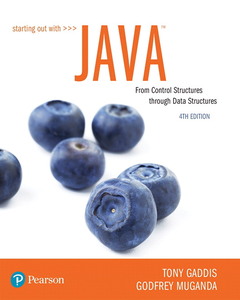Starting Out with Java (4th Ed.) From Control Structures through Data Structures
Auteurs : Gaddis Tony, Muganda Godfrey

For courses in computer programming in Java.
Provide a step-by-step introduction to programming in Java
Starting Out with Java: From Control Structures through Data Structures provides a step-by-step introduction to programming in Java. This text is designed to be used in a 2 or 3 semester sequence and covers everything from the fundamentals of Java programming to algorithms and data structures. As with all Gaddis texts, every chapter contains clear and easy-to-read code listings, concise and practical real-world examples, and an abundance of exercises. With the 4th Edition, JavaFX has replaced Swing as the standard GUI library for Java in chapters that focus on GUI development. The Swing and Applet material from the previous edition is available online.
Note: This ISBN contains an Access Code on the inside front cover that provides access to the Companion Website at www.pearsonhighered.com/cs-resources.
1. Introduction to Computers and Java
2. Java Fundamentals
3. Decision Structures
4. Loops and Files
5. Methods
6. A First Look at Classes
7. Arrays and the ArrayList Class
8. A Second Look at Classes and Objects
9. Text Processing and More about Wrapper Classes
10. Inheritance
11. Exceptions and Advanced File I/O
12. JavaFX: GUI Programming and Basic Controls
13. JavaFX: Advanced Controls
14. JavaFX: Graphics, Effects, and Media
15. Recursion
16. Sorting, Searching, and Algorithm Analysis
17. Generics
18. Collections and the Stream API
19. Linked Lists
20. Stacks and Queues
21. Binary Trees, AVL Trees, and Priority Queues
Online Appendices
Appendix A: The ASCII/Unicode Characters
Appendix B: Operator Precedence and Associativity
Appendix C: Java Key Words
Appendix D: Installing the JDK and Using the JDK Documentation
Appendix E: Using the javadoc Utility
Appendix F: More about the Math Class
Appendix G: Packages
Appendix H: Working with Records and Random Access Files
Appendix I: Configuring JavaDB and Installing Apache Derby
Appendix J: The QuickSort Algorithm
Appendix K: Named Colors
Appendix L: Answers to Checkpoints
Appendix M: Answers to Odd-Numbered Review Questions
Online Chapters
Chapter 22: Databases
Chapter 23: A First Look at GUI Applications with Swing
Chapter 24: Advanced Swing GUI Applications
Chapter 25: Applets and More
Online Case Studies
Case Study 1: Calculating Sales Commission
Case Study 2: The Amortization Class
Case Study 3: The PinTester Class
Case Study 4: Parallel Arrays
Case Study 5: The FeetInches Class
Case Study 6: The Serial Number Class
Case Study 7: A Simple Text Editor Application
Tony Gaddis is the principal author of the Starting Out With series of textbooks. Tony has nearly 20 years experience teaching computer science courses at Haywood Community College in North Carolina. He is a highly acclaimed instructor who was previously selected as the North Carolina Community College Teacher of the Year and has received the Teaching Excellence award from the National Institute for Staff and Organizational Development. The Starting Out With series includes introductory books using the C++ programming language, the Java™ programming language, Microsoft® Visual Basic®, Microsoft® C#®, Python, Programming Logic and Design, MIT App Inventor, and Alice, all published by Pearson.
Godfrey Muganda is Professor of Computer Science at North Central College. He teaches a wide variety of courses at the undergraduate and graduate levels including courses in Linux and Unix programming, Windows and .NET programming, web application Development, web services, data structures, and algorithms. He is a past winner of the North Central College faculty award for outstanding scholarship. His primary research interests are in the area of fuzzy sets and systems.
Practical organization helps students grasp important concepts before applying them
- Written in a clear, friendly, and easy-to-understand manner, the text uses a step-by-step approach to teach Java with each chapter covering a major set of topics and building knowledge as students progress through the book.
- Procedural programming is covered before object-oriented programming, ensuring that students understand fundamental programming and problem-solving concepts.
- Revised - JavaFX has replaced Swing in the chapters that focus on GUI development.
- New - Three chapters (Ch. 12-14) discuss basics of (GUI) applications with JavaFX, CSS styling and advanced user interface controls, and 2D shapes, animation, visual effects, playing audio and video, and responding to mouse and keyboard events.
- Updated - Online Database Chapter 22 now uses JavaFX instead of Swing for its GUI applications.
- Chapters 23 – 25 (Online): Legacy Swing GUI Chapters. The previous edition’s chapters on Swing GUI and Applet programming are now available on the book's companion website (www.pearson.com/cs-resources) as Chapters 23 through 25.
Pedagogical features convey and reinforce major concepts
- New - Several new, motivational programming problems have been added throughout the book.
- Example Programs are practical, real-world examples designed to highlight the current topic.
- Review Questions and Exercises appear in each chapter and present a thorough and diverse set of review questions and exercises.
- Programming Challenges and Case Studies present real-world problems to be solved, and solidify students’ knowledge of topics at hand offer.
- In the Spotlight, Concept Statements, Checkpoints, and Program O
Date de parution : 03-2018
Ouvrage de 1408 p.
10x10 cm
Disponible chez l'éditeur (délai d'approvisionnement : 12 jours).
Prix indicatif 145,64 €
Ajouter au panier


